


Bright colors depending on temperature
In this experiment a few compounds of mercury are shown, whose color depends on temperature. The colors, shown here, are remarkably bright and really beautiful. But here, things are just as in Nature. Bright colors denote danger and as such provide protection against predators. The same is true for the compounds, shown in this experiment. They are beautiful, but also exceedingly poisonous. This experiment must be carried out with great care. The picture below shows two of the bright colors. Both solids are HgI2, one being in stable form and the other in a metastable form.
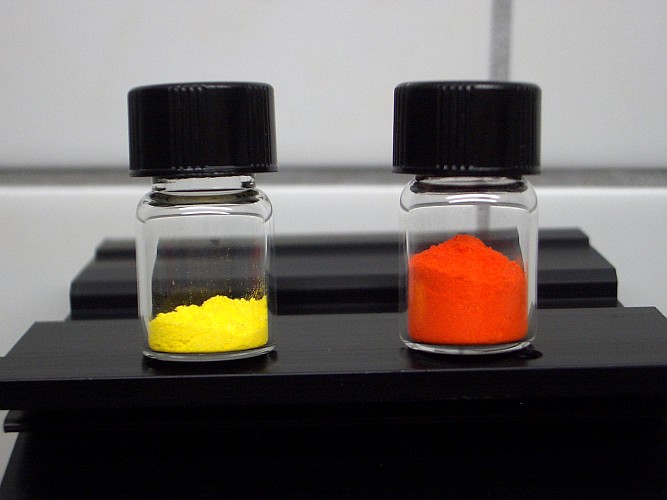
In fact, this page is a set of three experiments, showing the color of different compounds of mercury:
- mercury(II) iodide, yellow and bright orange/red color
- silver(I) tetraiodomercurate(II), yellow and orange color
- copper(I) tetraiodomercurate(II), bright brick-red and yellow/brown
![]()
![]() Required
chemicals for part 1 of this webpage:
Required
chemicals for part 1 of this webpage:
-
mercury(II) iodide
![]() Required
chemicals for part 2 of this webpage:
Required
chemicals for part 2 of this webpage:
-
mercury(II) iodide
-
potassium iodide
-
silver nitrate
![]() Required
chemicals for part 3 of this webpage:
Required
chemicals for part 3 of this webpage:
-
mercury(II) iodide
-
potassium iodide
-
cupric chloride (or copper sulfate)
-
sodium chloride
-
sodium sulfite
![]() Required
equipment:
Required
equipment:
- test tubes
- (optionally) small beaker
![]() Safety:
Safety:
-
 Mercury(II) iodide
and all compounds, produced in these experiments are exceedingly toxic and there is a
high risk of
cumulative effects. Be 100% sure that there will be no exposure at all to
these compounds!
Mercury(II) iodide
and all compounds, produced in these experiments are exceedingly toxic and there is a
high risk of
cumulative effects. Be 100% sure that there will be no exposure at all to
these compounds! - Silver nitrate is corrosive, it produces nasty black stains on the skin, which only disappear in a week or two by means of wear of the skin.
![]() Disposal:
Disposal:
- Do not flush the solutions in the sink! Keep them until they are brought to a proper chemical waste processing facility.
![]()
Part 1: Color of mercury(II) iodide depends on temperature
For this experiment very pure mercury(II) iodide is needed, such that no reactions occur during heating of the material. Impure samples may lead to less pronounced and less vivid colors and irreversible changes on cooling down. In this experiment, a commercial sample of mercury(II) iodide was used:
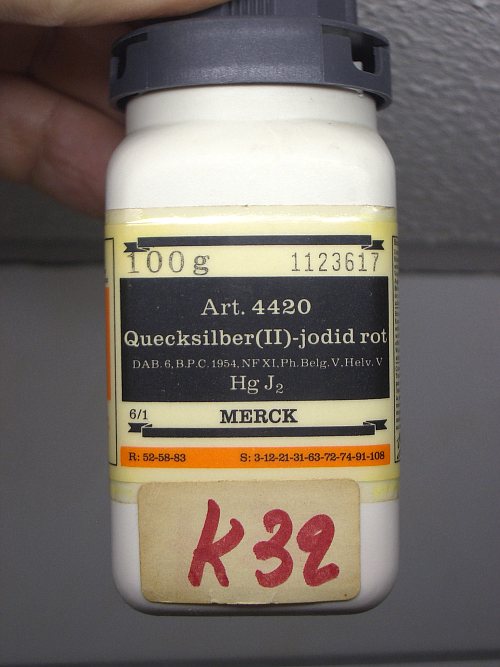
This sample of mercury(II) iodide is quite old, saved from a shutdown lab, but still in perfect condition (the bottle was still sealed when I received it).
The experiment itself is not very special and only involves some heating:
![]() Take a small spatula full of mercury(II) iodide and put this
in a test tube. Next, heat the test tube with the solid material slowly and
carefully. This results in slow change of color from orange to a deeper red
and at a certain point in time, the color quickly changes from deep red to
bright yellow. A series of pictures is given below, which show these
color-changes. The top picture shows the original mercury(II) iodide from the
bottle. The dark spot in the middle is due to the shadow of a larger granule on
top of the fine powder. The next picture shows that it has become deeper red and
already some yellow spots can be observed. The third picture shows the 'motion'
of the yellow↔red border through the solid. The fourth picture shows that all
material has become yellow, except some granules, which are on top of the fine
powder. Finally, the fifth picture shows that all of the solid has turned
yellow. When the color has changed to yellow, then stop heating!! When
heating is continued, then the solid sublimes, giving rise to mercury-containing
vapor. Unless you are working in a really good fume hood, do not continue
heating. When heating is stopped immediately after all solid has become
yellow, then one does not have to fear the presence of mercury-containing vapor.
Take a small spatula full of mercury(II) iodide and put this
in a test tube. Next, heat the test tube with the solid material slowly and
carefully. This results in slow change of color from orange to a deeper red
and at a certain point in time, the color quickly changes from deep red to
bright yellow. A series of pictures is given below, which show these
color-changes. The top picture shows the original mercury(II) iodide from the
bottle. The dark spot in the middle is due to the shadow of a larger granule on
top of the fine powder. The next picture shows that it has become deeper red and
already some yellow spots can be observed. The third picture shows the 'motion'
of the yellow↔red border through the solid. The fourth picture shows that all
material has become yellow, except some granules, which are on top of the fine
powder. Finally, the fifth picture shows that all of the solid has turned
yellow. When the color has changed to yellow, then stop heating!! When
heating is continued, then the solid sublimes, giving rise to mercury-containing
vapor. Unless you are working in a really good fume hood, do not continue
heating. When heating is stopped immediately after all solid has become
yellow, then one does not have to fear the presence of mercury-containing vapor.
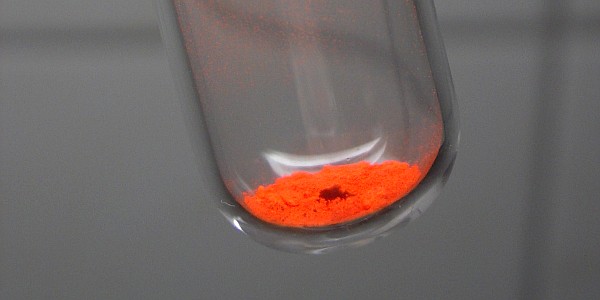
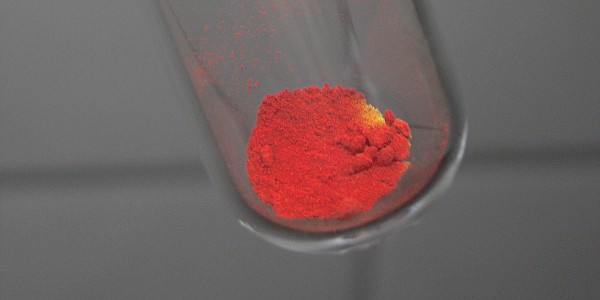
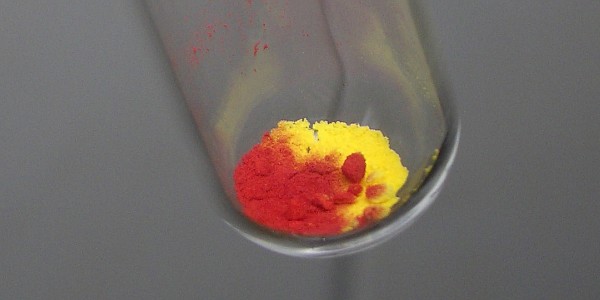
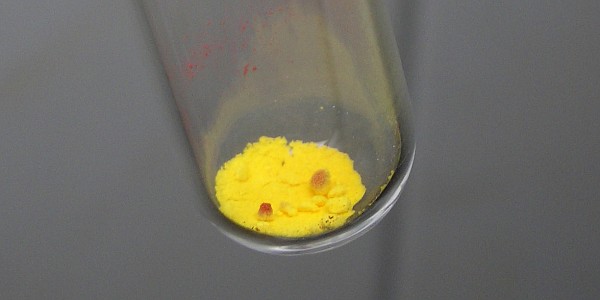
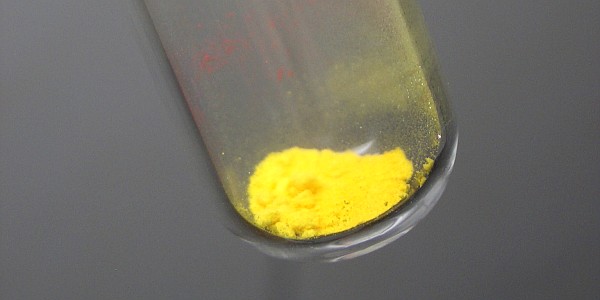
After the experiment, the solid is allowed to cool down for 20 minutes or so. Remarkably, nothing changes in this period. The test tube cools down completely, but the solid remains yellow. One even is capable of carefully transferring the yellow solid to a little vial without change of color.
![]() Violently swirl the test tube with the yellow solid (be sure that no dust can
escape from the test tube!!). When shaking is sufficiently violent, then the
color becomes orange/red again. This takes two minutes of violent shaking,
assuring that the solid is smashed against the glass.
Violently swirl the test tube with the yellow solid (be sure that no dust can
escape from the test tube!!). When shaking is sufficiently violent, then the
color becomes orange/red again. This takes two minutes of violent shaking,
assuring that the solid is smashed against the glass.
When the solid is put on a glass plate and crushed, then the color transition, back to red/orange can even be accomplished in seconds. So, strong mechanical pressure causes the cooled down solid to revert to red/orange again. As long as the solid is treated carefully, it remains yellow. So, the yellow state is metastable at room temperature, but mechanical agitation is sufficient to let it revert to the stable orange/red state.
The following two pictures show the result after a few seconds of violent shaking and after one minute of violent shaking. It is nice to see that the larger granule already has turned orange/red long before the fine powder has reverted to orange/red color. After two more minutes of violent shaking, the starting condition is reached again, the powder again is very bright orange/red, as shown in the first picture.
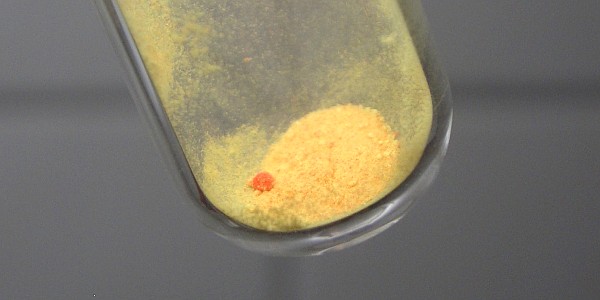
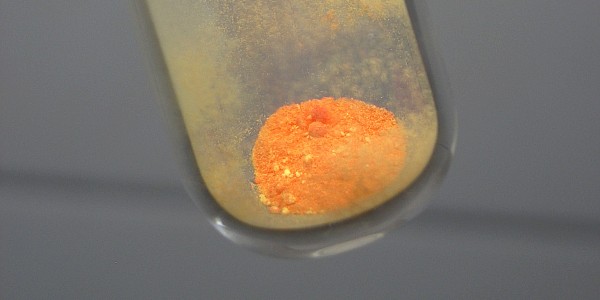
![]()
Preparation of solution of HgI42- for parts 2 and 3 of this webpage.
The second and third part of this webpage require the use of a compound, called potassium tetraiodomercurate(II), which has formula K2HgI4. In solution, this compound has ions K+ and HgI42-. A solution of this compound is made by dripping a solution of potassium iodide onto the solid, left over from part 1 of this experiment. The orange/red solid easily dissolves in the solution of potassium iodide:
HgI2 + 2I– → HgI42-
The solution of potassium iodide is made by dissolving a little spatula full of potassium iodide in 4 ml of water. This solution is added in portions of 0.5 ml and after each portion, the liquid is swirled in order to dissolve HgI2. The total amount of potassium iodide added is just below the amount, needed to dissolve all HgI2. The resulting solution is clear and light yellow. Whether this light yellow color is due to the color of HgI42- or is due to small amounts of I2 in solution cannot easily be determined. This was not further investigated in this experiment. The picture below shows the solution, with a tiny amount of solid HgI2 left.
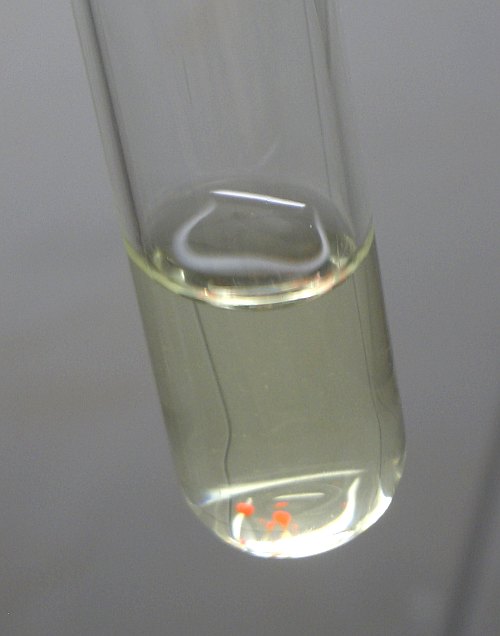
This solution is divided over two test tubes and one half is used for the experiment of part 2 of this webpage and the other half is used for the experiment of part 3 of this webpage.
![]()
Precipitation of Ag2HgI4, yellow when cold, orange when hot
In this experiment, a precipitate of silver(I) tetraiodimercurate(II) is made and this precipitate is heated and cooled down again. The color of this compound depends on temperature. It does not have a metastable state, such as the yellow HgI2. The color does not depend on the heating history, just on the current temperature. The experiment is outlined below.
![]() Dissolve
a small amount of silver nitrate in distilled water and add this to the solution
of K2HgI4. It does not really matter, whether there is
excess silver nitrate or not, the result of this experiment is not affected by
that.
Dissolve
a small amount of silver nitrate in distilled water and add this to the solution
of K2HgI4. It does not really matter, whether there is
excess silver nitrate or not, the result of this experiment is not affected by
that.
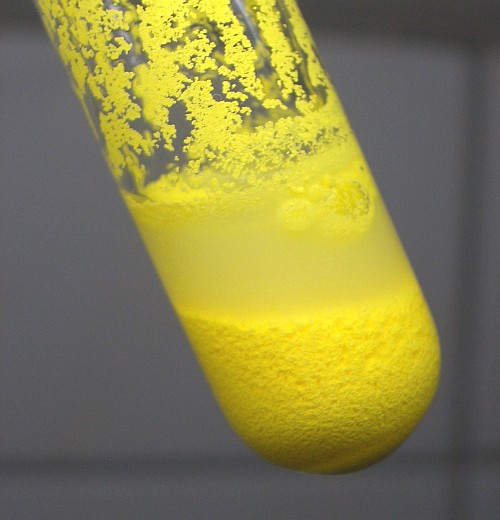
The picture above shows the result of mixing the two solutions and swirling the test tube. A curdy precipitate is formed, which quickly settles at the bottom. There also is some finer material, which does not quickly settle, but which makes the liquid appear turbid.
![]() Carefully heat the test tube with the curdy precipitate. Be sure that the liquid
does not bump out of the test tube due to hefty boiling, so swirl well while
heating. When this liquid becomes somewhat warmer, then the precipitate
coagulates and the liquid above the precipitate becomes perfectly clear and the
larger particles settle in just a second or so. One can also see that the
material is somewhat more orange at the right. This is the spot where the glass
was heated and at this place the material is somewhat warmer and already turns
orange a little bit.
Carefully heat the test tube with the curdy precipitate. Be sure that the liquid
does not bump out of the test tube due to hefty boiling, so swirl well while
heating. When this liquid becomes somewhat warmer, then the precipitate
coagulates and the liquid above the precipitate becomes perfectly clear and the
larger particles settle in just a second or so. One can also see that the
material is somewhat more orange at the right. This is the spot where the glass
was heated and at this place the material is somewhat warmer and already turns
orange a little bit.
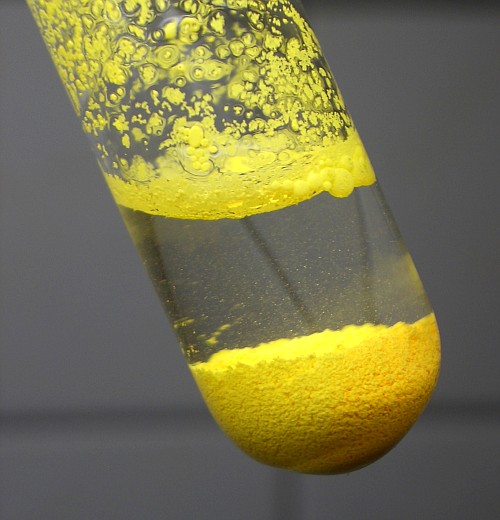
![]() On further heating, one can nicely see that the material in
the liquid turns orange. The material, sticking to the glass, near the top of
the test tube remains cold and so this remains yellow. The overview picture,
given below shows the contrast between the material in the hot liquid and the
cold material sticking to the glass.
On further heating, one can nicely see that the material in
the liquid turns orange. The material, sticking to the glass, near the top of
the test tube remains cold and so this remains yellow. The overview picture,
given below shows the contrast between the material in the hot liquid and the
cold material sticking to the glass.
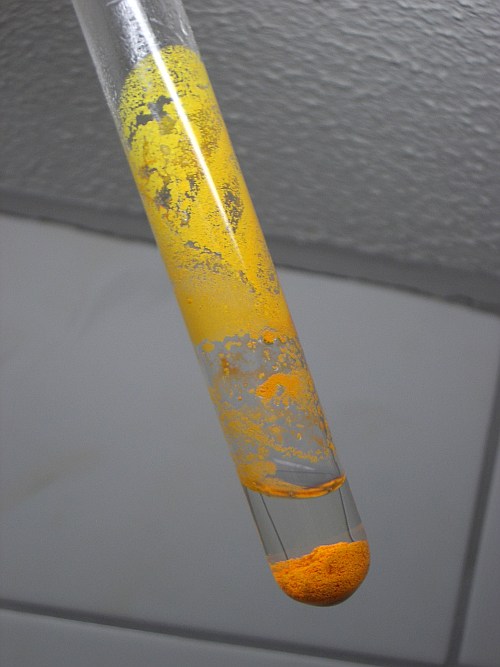
![]() When the liquid is boiled for a while, then the color even
becomes somewhat brighter, but the liquid also becomes turbid again. Some of the
curdy precipitate then is broken down in very small particles again.
When the liquid is boiled for a while, then the color even
becomes somewhat brighter, but the liquid also becomes turbid again. Some of the
curdy precipitate then is broken down in very small particles again.
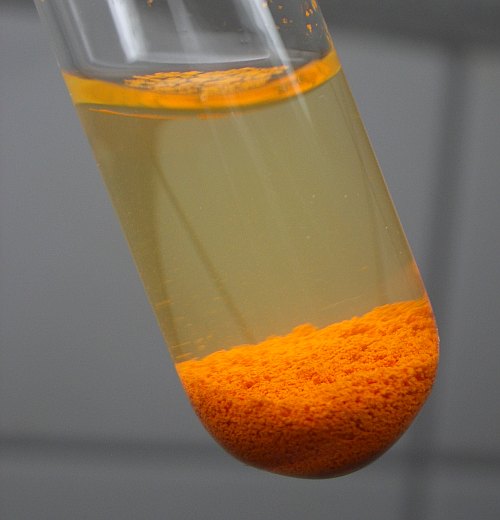
![]() Finally,
when this test tube is kept under a tap with cold running
water and is swirled somewhat, then the color of the precipitate very quickly
reverts to the bright yellow color. Another remarkable thing is that the cooling
down also makes the precipitate much finer. A fine powdery precipitate settles
at the bottom and a turbid liquid remains on top of this.
Finally,
when this test tube is kept under a tap with cold running
water and is swirled somewhat, then the color of the precipitate very quickly
reverts to the bright yellow color. Another remarkable thing is that the cooling
down also makes the precipitate much finer. A fine powdery precipitate settles
at the bottom and a turbid liquid remains on top of this.
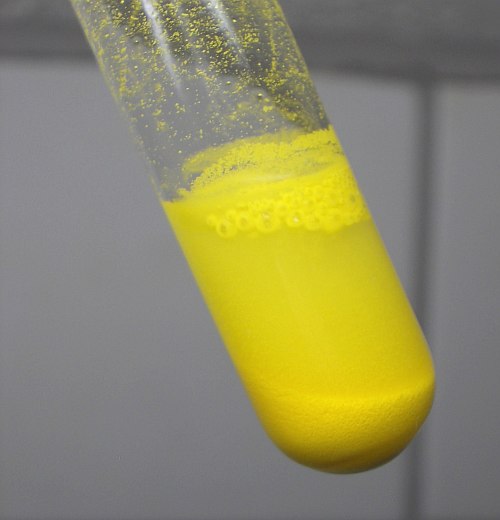
![]()
Precipitation of Cu2HgI4, red when cold, brown/yellow when hot
This is one of the most remarkable precipitates which can be formed from simple inorganic compounds. It has a really beautiful and surprising color.
![]() Before
the precipitate can be made, a solution must be prepared, which contains
copper(I). Copper(I) ions cannot exist on their own in aqueous solution, a
suitable coordinating agent is required to prevent disproportionation to
copper(II) and metallic copper. A suitable coordinating anion is plain chloride.
Such solutions also are very prone to aerial oxidation, so a suitable reductor
must be present as well. The solution only must be mildly reducing, otherwise
the HgI42- anion is reduced to metallic mercury and iodide
ion. A suitable reductor is sulfite ion. This reduces copper(II) ion in the
presence of chloride ion and does not reduce the HgI42-.
Preparation of this solution is described on a
separate webpage.
Before
the precipitate can be made, a solution must be prepared, which contains
copper(I). Copper(I) ions cannot exist on their own in aqueous solution, a
suitable coordinating agent is required to prevent disproportionation to
copper(II) and metallic copper. A suitable coordinating anion is plain chloride.
Such solutions also are very prone to aerial oxidation, so a suitable reductor
must be present as well. The solution only must be mildly reducing, otherwise
the HgI42- anion is reduced to metallic mercury and iodide
ion. A suitable reductor is sulfite ion. This reduces copper(II) ion in the
presence of chloride ion and does not reduce the HgI42-.
Preparation of this solution is described on a
separate webpage.
![]() Add the
copper(I) solution to the solution of K2HgI4. This results
in formation of a really beautiful red precipitate of Cu2HgI4.
Add the
copper(I) solution to the solution of K2HgI4. This results
in formation of a really beautiful red precipitate of Cu2HgI4.
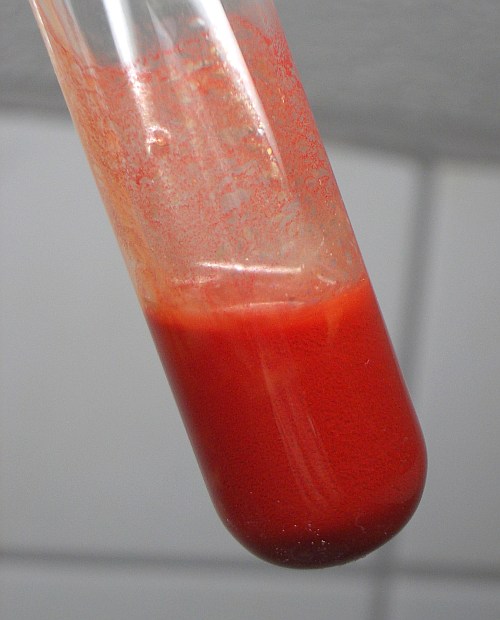
![]() Heating of this test tube, while constantly swirling, causes
the precipitate to become more curdy, and the color shifts from bright red
through brown to yellow/brown. The two pictures below show the brown color when
the liquid has been heated somewhat and the yellow brown color, which is
obtained when the liquid just starts boiling.
Heating of this test tube, while constantly swirling, causes
the precipitate to become more curdy, and the color shifts from bright red
through brown to yellow/brown. The two pictures below show the brown color when
the liquid has been heated somewhat and the yellow brown color, which is
obtained when the liquid just starts boiling.
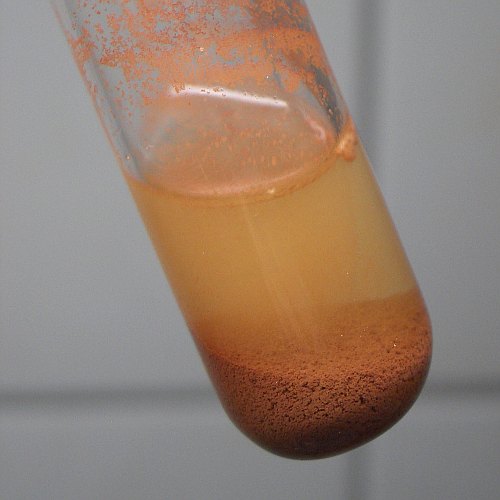

The upper part of the test tube still is cold after the heating, and any solid, sticking to the glass still has the bright red color, which is in nice contrast with the yellow/brown color of the solid in the hot liquid.
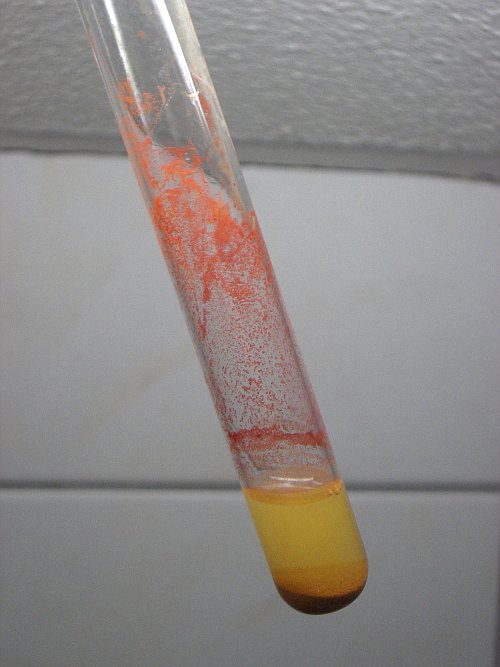
![]() Finally, when the test tube is put under the cold water from
a running tap and is swirled, then within just a few seconds, the color reverts
to the bright red.
Finally, when the test tube is put under the cold water from
a running tap and is swirled, then within just a few seconds, the color reverts
to the bright red.
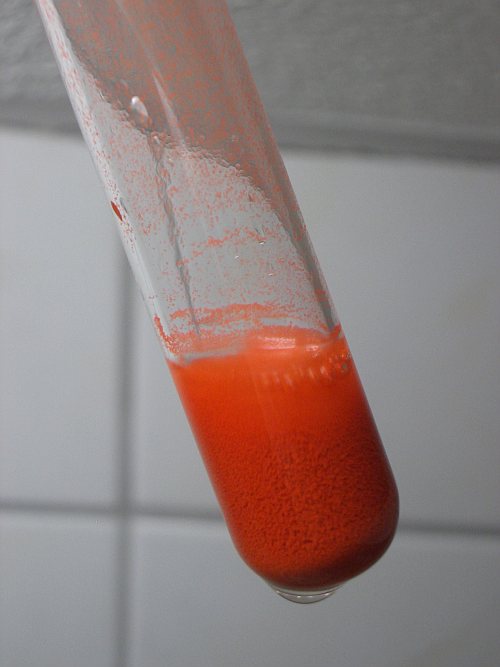
![]()
Discussion of results
In all three experiments, there is a color-change of the compound, when the temperature changes. However, there also is a marked difference.
- In the first experiment, there first is a gradual change of color (which also is not really striking) and at a certain temperature, there is a sharp transition from one color to another. On cooling down, the color does not simply revert. It really seems as if a new compound is formed.
- In the other two experiments, there is a gradual change of color with temperature. When temperature increases, then a certain color change occurs and when temperature decreases again, then changes occur in reverse order. For each temperature, there is a color, and the color does not depend on the history of heating.
Part 1: Mercury(II) iodide
In this experiment, a special kind of phase transition is demonstrated. At 126 °C the solid changes. The crystal structure (spatial arrangement of mercury and iodine atoms) abruptly changes at this temperature. The density of the yellow compound is less than the density of the red/orange compound. It is the same compound, but in another phase.
This actually can be compared to the more classical phase transitions, such as ice, which changes to water at 0 °C. With HgI2, there is a phase transition from one solid form to another solid form. Above 126 °C, the yellow solid form is the stable one, and below 126 °C the red/orange solid form is the stable one.
On cooling down, the yellow form does not revert to the red/orange form again. This phenomenon can be compared to supercooling of water. If very pure water is cooled down slowly and is not disturbed, then the water can remain liquid at temperatures well below the freezing point of 0 °C. Sudden motion of the liquid (e.g. shaking, or scratching the container, in which the liquid is kept) then leads to quick freezing of the water. The metastable supercooled state then is disturbed. A similar phenomenon exists for the metastable yellow form of HgI2 at room temperature. This is the "supercooled" form of yellow HgI2. This "supercooled" form of yellow HgI2 is more stable than supercooled water. It requires somewhat stronger agitation, but with some mechanical pressing or violent shaking enough agitation is provided to make it revert to its normal red/orange form at room temperature.
Part 2 and 3: Silver- and copper(I) tetraiodomercurate(II)
Mercury(II) iodide forms a rather stable complex with iodide ion, which does not dissociate, not even at low concentration or at high pH:
HgI2 + 2I– → HgI42-
This anion forms beautifully colored precipitates with many metal ions. Most notably are the precipitates with silver and copper(I), which have the added property that their color depends on temperature. The reaction equations for formation of these precipitates are the two ones given here. The silver-compound is formed from the plain aqueous silver ion, the copper(I)-compound is formed from the dichlorocuprate(I) complex ion, as present in the specially prepared copper(I) solution.
2Ag+ + HgI42- → Ag2HgI4(s)
2CuCl2– + HgI42- → Cu2HgI4(s) + 4Cl–
Both of these colors have a color, depending on temperature. This is not like the sharp phase transition of HgI2, as explained above. Both the silver- and the copper-compound have different solid phases, but there are multiple phases of these, depending on temperature, pressure and purity. This makes color changes less precisely defined. If one could obtain a very pure sample of these compounds, then one could determine more precise temperatures at which a color change occurs, or a certain pressure at a given temperature at which a color change occurs.